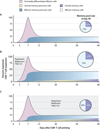Pharmacologic induction of CD8+ T cell memory: better living through chemistry
- PMID: 20371454
- PMCID: PMC3241001
- DOI: 10.1126/scitranslmed.3000302
Pharmacologic induction of CD8+ T cell memory: better living through chemistry
Abstract
The generation of a robust population of memory T cells is critical for effective vaccine and cell-based therapies to prevent and treat infectious diseases and cancer. A series of recent papers have established a new, cell-intrinsic approach in which small molecules target key metabolic and developmental pathways to enhance the formation and maintenance of highly functional CD8(+) memory T cells. These findings raise the exciting new possibility of using small molecules, many of which are already approved for human use, for the pharmacologic induction of immunologic memory.
Figures


References
Publication types
MeSH terms
Substances
Grants and funding
LinkOut - more resources
Full Text Sources
Other Literature Sources
Research Materials
Miscellaneous

